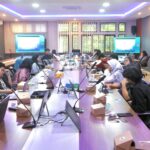By Dorothy-Grace Guerrero*
Since it joined the World Trade Organisation in 2001, China increased its involvement in the East Asian regional economic cooperation to enhance its global competitiveness. The Chinese government shifted its diplomatic strategy from that of a developing country focused on issues of domestic concerns towards one that is taking regional and global leadership. This raised questions concerning the nature of China’s rise and its implications.
China is indeed rapidly becoming the predominant power in Asia Pacific and is starting to challenge the role of both the United States and Japan in the region. The question is: will China’s increasing importance in the region make ASEAN countries more prosperous, more stable, and equitable? To address this question, one must understand the current importance of China and the many challenges that come with China’s new role in the region.
ASEAN-China Relations
The countries within the Association of Southeast Asian Nations (ASEAN) started to strengthen their bilateral relationship with China in recognition of China’s growing role as a source of investment. The ASEAN-China relations began in 1991 when China first expressed its interest for closer cooperation with ASEAN during the 24th ASEAN Ministerial Meeting in Kuala Lumpur. But it is only during
the 29th ASEAN Ministerial Meeting in Jakarta in 1996 that China gained full dialogue status with ASEAN.
All mechanisms at the working level were coordinated through the ASEAN-China Joint Cooperation Committee. During this meeting China also agreed to the establishment of the ASEAN-China Cooperation Fund. The ASEAN-China Senior Officials Political Consultation was also set up as a forum on political and security issues. A Code of Conduct in the use of the South China Sea was also established as a means to prevent conflict and promote peace in the region.
The financial crisis that hit Asian countries in 1997 brought together the region’s north and south to discuss common responses to the crisis during the ASEAN meeting that year in Kuala Lumpur. The evolution of the Asean Plus Three (Japan, China and South Korea) came as a result of a recommendation of the East Asian Vision Group that was formed to propose possible substantive areas of cooperation.
ASEAN adopted the Asean Plus Three (APT) Framework during the 2004 ASEAN Summit in Vientiane, Laos. This resulted in the historic First East Asian Summit (EAS) in Kuala Lumpur in 2005.
Two Giants in One Mountain
An East Asian Summit (EAS) was held despite tensions that came out on the later process of its formation. The Summit was China’s floating balloon for the realization of an East Asia Community, which was inspired by the case of the European Union. China saw an opportunity to steer East Asian multilateralism along the lines of the Shanghai Cooperation Organization to serve Beijing’s strategic goals and further weaken the US influence in East Asia1. Beijing’s diplomatic offensive was met by the strategy of including India, Australia and New Zealand by Japan and ASEAN members that were wary of an East Asia Co-Prosperity Sphere under China’s leadership. In effect the 2005 EAS was a proxy battle between China and Japan.
The rift in the first EAS was the tip of an iceberg, which is the Sino-Japanese conflict. Scholars and diplomats in the region are in agreement that the future of an East Asia Community will remain bleak if the two giants will not settle their historical differences. The feud is continually reignited by a number of sparks, which include: Beijing’s blockage of Japan’s possibility to have a permanent seat in the UN Security Council; the competing claims to petroleum deposits and islands in the East China Sea; and, China’s irritation at the visits of former Prime Minister Koizumi to the Yasukuni Shrine where Japan’s war dead, fourteen of which considered as war criminals by China and South Korea, were buried.
There is a saying that two giants could not co-habit the same mountain. It seems that for the time being it will remain true in the case of China and Japan, more so considering that the “mountain” is getting more and more crucial for geo-strategic considerations.
ASEAN-China Free Trade Agreements
The ASEAN-China Free Trade Agreements (ACFTA) is a crucial component of East Asian regional economic integration. In 2002, Chinese and ASEAN Leaders signed the Framework Agreement on Comprehensive Economic Cooperation and decided that an ASEAN-China FTA would be set up in 10 years.
When realized, the ASEAN-China FTA will be the largest FTA in Asia. It will also be the biggest FTA between developing countries and biggest in terms of population covered representing a market of 1.85 billion consumers and a combined gross domestic product of almost 2.5 trillion dollars. The ACFTA will be fully implemented for the ASEAN-6 in 2010, and will integrate Vietnam, Laos, Myanmar and Cambodia by 2015.
On January 1, 2004 the two parties began implementing what China called an “Early Harvest Plan” or EHP. This plan grants a 3-year duty free entry for ASEAN goods into the Chinese markets. After this, China’s manufactured goods will have full free tariff access to Southeast Asian markets. This secures China’s access to the region’s raw materials and at the same time removes barriers to China’s exports. The EHP cut tariffs on more than 500 products as part of the efforts to facilitate the FTA. The ACFTA will strengthen China’s clout by making it the center of gravity in Asia and surpassing the influence of Japan and the US.
The 8th China – ASEAN Summit on November 29, 2004 in Vientiane resulted in a package of agreements on trade in goods and dispute settlement. China and the Asean began to cut tariffs on more than 7,000 products, a move indicating the start of the substantial tariff reduction phase between the two parties.
Trade between China and ASEAN has been on the rise, growing at an annual average of 19% between 1995 and 2002. The 2002 trade record is US$ 54.8 billion2. This leapt to more than US$100 billion for the first time in 2004 and further increased to US$130.37 billion in 20053. ASEAN trade with Japan and the US remained higher at $136 billion each in 2004, but this is expected to be overtaken by ASEAN-China trade soon.
Supporters of ACFTA argue that Chinese and ASEAN economies complement one another. But China’s expansion is not being welcomed by everyone. In fact, reaction to China’s growing economic presence is increasingly becoming negative especially from small farmers and manufacturers in the region. Those in electronics, furnitures, motorcycles, and fruits and vegetables, increasingly see China as a threat. In Thailand, farmers are despairing that they could not sell their own produce anymore because of the low-priced Chinese vegetables that invade the markets in rural towns and cities in the country4. Malaysian and Indonesian workers are also complaining about jobs being lost to Chinese workers due to closures of enterprises that are losing orders to China. Increased Chinese textile exports since 2005 to Cambodia and Vietnam started to supplant local producers in the two countries5.
The strong drive and interest by the ASEAN elite to deepen economic ties with China is not shared by farmers and small businesses that fear the competitive advantage of China in churning out low-priced goods. Environmentalists and interests groups also worry about the impacts of Chinese demand on natural resources in the region.
Development Cooperation
In recent years, the flow of Chinese development assistance to Southeast Asia, especially to Laos, Burma and Cambodia, has been increasing. In the Greater Mekong Sub-region in general, China is actively pursuing cooperation for the construction of power plants and regional grid interconnection. China also finance projects in Vietnam Kon Giang 2 and Bao Loc) and the rest of Southeast Asia6. In Malaysia, it supports an ongoing project for the rehabilitation of Tenompangi hydropower plant in Sabah. Laos’ Nam Tha and Tha Som and Myanmar’s Kun are also benefiting from China’s external development assistance.
China is balancing its deepening trade partnership with ASEAN with development support. China is now trying to match Japan’s role in development assistance, which remains dominant. Clearly, the current swirl of Chinese money to development projects within ASEAN is intended to warm the relationship between China and its neighbors.
However, there are hard edges to Beijing’s soft-power economic push into Southeast Asia. China is perceived as a source of many environmental problems. Its development of the Mekong River within its border negatively affects the countries downstream, which includes Thailand, Laos, Cambodia and Vietnam. Last year, the Cambodian case of pine wood plantation operated by Wuzhishan in Mondolkiri area that involves 199,999 hectares of land leased to China for 99 years showed some disregard to the local population. As China continues with its charm offensive through government assistance and regional investment, it must also own up to increasing responsibility.
From Pax Americana to Pax Asia Pacifica?: China-ASEAN Military Cooperation
China’s diplomatic offensive in Southeast Asia has raised concerns about the implications of China’s rise on the balance of power in Asia pacific. Those fearing a China threat scenario see China’s increasing influence and political muscle flexing as signals of its interest to attain regional hegemony. The US, for instance, has reasons to be threatened as China’s rise could disrupt its preeminent role in Asia, including its ability to shape regional politics to serve its interests.
China skeptics argue that as China’s economic power grows, it may seek to expand its political power because it wants to protect and affirm its interests. They fear that over time China might use its growing military capability to control politics in Asia in the same manner as the US. China on the other hand is continually taking pains to ensure that its rise is perceived as non-threatening. Chinese officials always point out that China is expanding its political influence through the institutional approach, that is, by means of international co-operation. It has established itself as an Asian power and world power through increased integration into the international community.
China’s peaceful rise is being pursued through trade, confidence building measures, development cooperation and assistance. There is also a growing perception that China is not challenging the US but is rather “filling-up” the space vacated by the US as it gets pre-occupied somewhere else.
With ASEAN, China has never been aggressive. It signed in October 2003 the Treaty of Amity and Cooperation7, which indicates China’s commitment to respect the ideals long held by ASEAN – sovereignty and non-interference in each other’s internal affairs, and settlement of disputes in peaceful manner. In terms of military cooperation China initiated Security Policy Conferences in the Asian Regional Forum (ARF), which were held in Beijing in 2004 and in Vientiane in 2005. There are now Joint Military exercises with Australia, the Philippines and Thailand, training of ASEAN officers and provision of language trainings to military personnel from ASEAN countries. All this is done to show that China identifies with the regional security ideals of ASEAN.
China’s initiative on the Code of Conduct that will come up with plans for joint development in the South China Sea also pacifies, at least for the time being, ASEAN Member claimants of the disputed territories. In the past, conflicts between the Philippines, China and Vietnam erupted over control of islands in the South China Sea. In March 2005, state-owned oil companies from the three countries signed a three year agreement for joint exploration for oil and gas in the disputed area8.
However, there remain security issues involving China that pose a challenge to ASEAN and to Asia generally. The issue of Taiwan is key. China’s insistence on the One China Policy may not match the economic imperatives of ASEAN all of the time. The Singaporean Deputy Prime Minister Lee Hsien Loong’s (son of former leader Lee Kuan Yew) visit to Taiwan in July 2004 displeased Beijing and caused the cancellation of the visit by Chinese Central Bank Governor Zhou Xiaochuan to Singapore9.
At this point, it will still take some more time to see whether China’s gestures of non-interference, cooperative security and “filling-in” moves will indeed eat at the role of the US in the region. Pentagon’s Quadrennial Defense Review released in February 5, 2006 reaffirms that the US will not allow the rise of a competing superpower10. Indeed, the US has taken steps to re-establish relationships with ASEAN countries. However, the Bush administration’s blinkered focus on military response to the challenge of terrorism increased anti-American sentiments among Muslims in Asia.
China as Model?
While China has yet to gain the status of an alternative to US leadership in the region, ASEAN could always use China’s potential as a possible alternative in its balancing act with the US and Japan in various political, economic and security negotiations.
There are some lessons that other developing countries could learn from China: China demonstrated the importance and effectiveness of state ownership of key sectors, of the banking system, strong state control over capital allocation, powerful regulation of investment (foreign and domestic) and international trade.
It is important that we take a more careful look at the nature of the growth process in East Asia. The dynamic growth of the tiger economies in the 1980s that followed the NIC (newly industrialized country) model of development did produce improvements in the living conditions and resulted to dramatic development of the formal sector of employment in South Korea, Taiwan, etc. However, such gains came at a very high cost.
China’s growth under the current globalization of capital accumulation is accompanied by much harsher conditions for working people. The hype about such growth merely paints a false picture of what capitalist success means. The interest of those that are promoting such one-sided picture is to encourage the view that adopting the policies of the East Asian countries (growth before democracy and equality) can produce economic miracles like China. Not only is that a big lie, it also hide the more alarming situation that even the gains that were achieved at the cost of social and environmental injustice are fast disappearing.
The Way Ahead… Will People Matter?
ASEAN is the “mother of all regional formations” in Asia. It has gone through a long history, challenges and rebirths. The presence of China in the evolving regional community and its role in the governance of the region’s economic, political and security relations have potential benefits to member countries. China’s leadership in combating drug trafficking in its border could contribute to the solution of transnational crimes. Its initiatives for deeper cooperation on health issues like the spread of severe acute respiratory syndrome or SARS and HIV/AIDS will certainly give a big push to the efforts towards addressing these problems.
If successful, China’s efforts to solve its internal problems through its new social policies for the countryside may provide a good model for a redefined activist state’s role in economic governance. However, China’s growing influence does not necessarily ensure human security, deeper democracy, political transparency and protection of the environment and human rights in the region. Despite growing sentiment of anti-Americanism in the region, the US is still considered by many as a more democratic country and a better supporter of human rights.
The China-Africa Summit held in Beijing in November 2006 showed the state of China’s appreciation for the participation of civil society organizations in geo-political events. NGOs were not part of the big meeting, which was attended by 43 African heads of state. A stronger civil society participation in ASEAN affairs will most certainly not be championed by China.
Asian movements, NGOs and campaign groups are increasingly recognizing the importance of engaging China. To do so, it is important to understand China better and know their counterpart/like-minded organizations within the mainland. It is crucial to engage China and work with the increasing number of people and organizations there that are working to make China more responsive to social concerns.
*Dorothy-Grace Guerrero is a Research Associate with Focus on the Global South and heads its China Programme. She may be reached at [email protected].
1 Mohan Malik, “The East Asia Summit: More Discord then Accord”, YaleGlobal, December 20, 2005
2 Bian Shen, “New Opportunity for ASEAN-China Trade”, Beijing Review, May 1, 2003.
3 Li Guanghui, China-Asean FTA both necessary and beneficial, China Daily, November 6, 2006.
4 Supara Janchitfah, “Lost in Statistics”, Bangkok Post, 13 August 2006.
5 Denis Gray, “Anxiety and Opportunities Mount as Chinese Colossus Exerts Influence on Southeast Asia”, Associated Press, March 30, 2004.
6 Please see details of these projects at the Rivers Watch East and Southeast Asia webpage, www.rwesa.org .
7 People’s Daily, China joins Treaty of Amity and Cooperation in Southeast Asia, October 9, 2003.
8 ASEAN, Declaration on the Conduct of Parties in the South China Seas, 04 November 2002, www.aseansec.org/13163htm
9 Elizabeth Economy “China’s Rise in Southeast Asia: Implications for Japan and the United States”, Japan Focus, 10 October 2005.
10 Japan Focus, April 2006.








